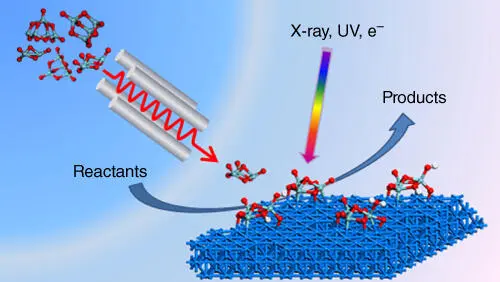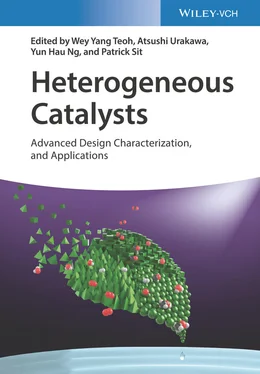When cluster sizes are small, the gaps between MOs are significant compared with the energy of the environment (approximated by kT ), and electrons occupy the lowest available energy levels. Each M ncluster will have a highest occupied molecular orbital (HOMO) and a lowest unoccupied molecular orbital (LUMO) with energies that depend on n . The size dependence of energy levels has implications for potential use of clusters as active sites in catalysts. Strong chemical interactions underpinning the catalytic actions of bond breaking and bond making involve sharing of the electron density between the active site of the catalyst and molecule(s) of the reagent. For example, in order to activate an H 2molecule by breaking the hydrogen–hydrogen bond, the active site must be able to transfer enough electron density into antibonding orbital of H 2. Clusters offer unprecedented opportunities to fine‐tune the electronic nature of the active site (and hence its reactivity) by choosing a specific cluster with an appropriate type and number of atoms. Clusters are often called “superatoms,” with the notion that a periodic table can be built up in the third dimension whereby the energy levels of the cluster are altered by changing the number of atoms (of the same element) in the cluster. At the other extreme ( Figure 5.1, right) are cases of the bulk metal lattices or large NPs, with electronic properties described by band theory. The number of atoms in such systems is huge (think of 1 mol, 6.022 × 10 23atoms), and hence number, and energy density, of MO‐like orbitals is also huge, making gaps between adjacent orbitals smaller than the intrinsic uncertainties of their energies. Hence the energy levels form continuous “bands” that are allowed to be occupied by electrons (cf. forbidden “gaps” between these bands). At 0 K, electrons in the bulk‐like system occupy the lowest possible energy bands to an upper level called the Fermi level. If the Fermi level lies below the top of a partially occupied by electron band, under ambient conditions, a Maxwell–Boltzmann distribution of electrons will prevail with respect to the energies and mobility of the electrons of the system, yielding a conductor.
Let us now traverse from the extreme of the bulk metal back to clusters on the example of gold. As gold metal particles become nanosized, new characteristics emerge, such as unique optical properties due to the surface plasmon resonance enabled by the nano‐confinement of the shared electrons. Upon reaching size of ∼3 nm for Au particles on titania [2] or between Au 246and Au 279for Au clusters decorated with thiol ligands (‐SR) [3], the continuous bands typical of metals break up due to these systems being composed of small enough number of atoms. The energy differences between at least some orbitals within the former continuous band become significant, leading to appearance of the band gaps and onset of the semiconductor behavior. In the case of Au NPs on TiO 2, such a transition coincides with emergence of superior catalytic activity in CO oxidation [2]. The size of metal particles at which such a transition occurs could be assigned as the upper limit of metal cluster sizes, enabling differentiation of clusters from larger NPs based on the electronic structures of each class.
5.2 Catalysts Made by Deposition of Clusters from the Gas Phase Under Ultrahigh Vacuum
As Professor Stefan Vajda of Argonne National Laboratory (United States) points out in his recent review, “One of the most direct methods for size‐selected deposition of catalytic materials involves the use of a gas‐phase cluster ion source (cations or anions) and a downstream mass spectrometer to mass‐select nanoclusters prior to deposition onto a substrate. This approach is particularly effective for investigations of small nanoclusters, 0.5–2 nm (<200 atoms), where the rapid evolution of the atomic and electronic structure makes it essential to have precise control over cluster size” [4]. This subsection will only briefly cover this “top‐down” approach of fabricating clusters by breaking up macroscopic metals; interested readers are referred to Refs. [4, 5] for a detailed review of this approach [5]. The mixture of clusters obtained can be fine‐tuned with respect to particle sizes within a so‐called collision cell or aggregation chamber filled with inert gas at low pressure to obtain larger species if needed (the inert gas condensation method). Most importantly for this approach, selection of clusters with a specific mass is performed using a so‐called mass filter – a technology used in mass spectrometry. To be precise, mass selection is performed based on the m / z value, where z is the charge of the ion and m is its mass. Separating uncharged, neutral particles [6] is much more difficult, since the trajectories of the ions (charged particles) can be manipulated by the electromagnetic fields. Importantly, such separations are performed under high or ultrahigh vacuum (UHV) in order to minimize collisions of the cluster ions of interest with other species in the gas phase, thus increasing so‐called mean free path of cluster ions to the lengths matching or exceeding the dimensions of the apparatus. Hence, such techniques are often referred to as UHV techniques. Quadrupole mass filters ( Figure 5.2) operate using four parallel metal rods precisely machined to micron level to which direct current (DC) and superimposed alternating current (AC) radiofrequency (RF) potentials are applied [7]. Cluster ions are drawn toward an oppositely charged rod, but if the rod polarity changes before the ion reaches it, the ion will change direction. Thus, the ions develop complex trajectories, with only those ions of a specific m / z surviving passing through the quadrupole mass filter. Firstly, the use of the quadrupole allows researchers to obtain a mass spectrum representative of the cluster ion species present in the aggregation chamber of the instrument. Secondly, after selecting cluster ion species of interest, a specific set of quadrupole parameters can be chosen so that only these selected cluster ion species pass through the filter. If the mass‐resolving power of the quadrupole is high enough, unique and size‐specific cluster ion species can be generated in this way.

Figure 5.2 Illustration of selecting specific cluster species using quadrupole for deposition on substrate followed by model catalytic studies and characterization.
Source: Reprinted with permission from Vajda and White [4]. Copyright 2015, American Chemical Society. (See online version for color figure).
Size‐selected cluster ions can be deposited under UHV onto a wide range of substrates with good control of the surface coverage, which is typically expressed as a fraction of a monolayer (ML). In order to maintain cluster nuclearity (i.e. number of atoms per cluster core), a technique of “soft landing” was developed whereby clusters with low kinetic energy are used to avoid their fragmentation or migration over long distances, which could lead to aggregation via collisions with clusters already at the surface. Average deposition energies of less than 0.2 eV per atom within a cluster are consistent with “soft‐landing” conditions, while coverage is usually kept well below the ML level (0.2–0.3 ML or less). Fabrication of model catalysts can be performed in this way with mass‐selected clusters becoming the predominant active sites on the support. For instance, ∼10 13clusters of a specific size can be delivered within UHV chamber to cover an area of ∼10–20 cm 2of the support over period of 10–60 minutes [4]. The major advantage of this method is access to a wide range of cluster sizes, potentially without “gaps” with respect to the cluster size, thus enabling detailed size effect studies. For example, Figure 5.3presents the results of the study of Au −clusters with sizes from 2 to 20 atoms whereby clusters of all sizes within this range were studied in separate experiments.
Читать дальше


